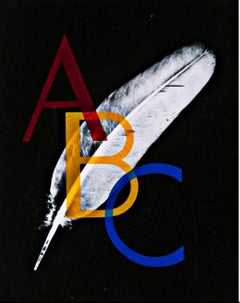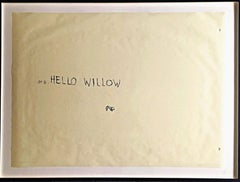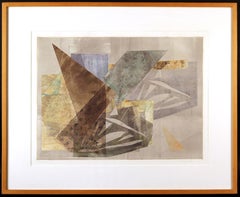Pencil Abstract Prints
1990s Pop Art Pencil Abstract Prints
Linen, Mixed Media, Pencil, Screen
1970s Surrealist Pencil Abstract Prints
Mixed Media, Pencil, Lithograph, Screen
1980s Contemporary Pencil Abstract Prints
Archival Paper, Pencil, Graphite, Lithograph
1990s Pop Art Pencil Abstract Prints
Paper, Pencil, Monotype
1970s Pop Art Pencil Abstract Prints
Mixed Media, Graphite, Lithograph, Offset
1980s Abstract Geometric Pencil Abstract Prints
Monotype, Pencil, Lithograph
1970s Abstract Geometric Pencil Abstract Prints
Pencil, Graphite, Lithograph
1980s Post-Minimalist Pencil Abstract Prints
Graphite, Lithograph
1980s Pop Art Pencil Abstract Prints
Pencil, Lithograph, Screen
1970s Pop Art Pencil Abstract Prints
Other Medium, Lithograph, Pencil
1970s Pop Art Pencil Abstract Prints
Masonite, Pencil, Screen
1960s Abstract Pencil Abstract Prints
Lithograph, Pencil
1980s Post-Minimalist Pencil Abstract Prints
Graphite, Lithograph
2010s Street Art Pencil Abstract Prints
Screen, Pencil
1970s Abstract Expressionist Pencil Abstract Prints
Mixed Media, Pencil, Graphite, Engraving, Drypoint, Etching, Aquatint
1980s Contemporary Pencil Abstract Prints
Pencil, Lithograph
1960s Pop Art Pencil Abstract Prints
Screen, Pencil
1960s Pop Art Pencil Abstract Prints
Screen, Pencil
2010s Pop Art Pencil Abstract Prints
Graphite, Screen
1980s Abstract Pencil Abstract Prints
Pencil, Lithograph
Early 2000s Contemporary Pencil Abstract Prints
Offset, Pencil, Lithograph
1990s Abstract Pencil Abstract Prints
Lithograph, Pencil
2010s Street Art Pencil Abstract Prints
Screen, Pencil
2010s Abstract Pencil Abstract Prints
Oil Pastel, Graphite, Woodcut
2010s Abstract Pencil Abstract Prints
Oil Pastel, Graphite, Woodcut
2010s Abstract Pencil Abstract Prints
Oil Pastel, Graphite, Woodcut
2010s Abstract Pencil Abstract Prints
Oil Pastel, Graphite, Woodcut
1970s Abstract Expressionist Pencil Abstract Prints
Paper, Ink, Pencil
2010s Contemporary Pencil Abstract Prints
Archival Ink, Archival Paper, Color Pencil, Monoprint, Woodcut
1970s Abstract Pencil Abstract Prints
Paper, Mixed Media, Drypoint, Mezzotint, Linocut, Pencil
Early 2000s Contemporary Pencil Abstract Prints
Handmade Paper, Photogravure, Mixed Media, Pencil
2010s Contemporary Pencil Abstract Prints
Archival Ink, Archival Paper, Color Pencil, Monoprint, Woodcut
2010s Pop Art Pencil Abstract Prints
Screen, Pencil
1980s Post-Minimalist Pencil Abstract Prints
Graphite, Lithograph
1960s Pop Art Pencil Abstract Prints
Pencil, Screen
1980s Surrealist Pencil Abstract Prints
Etching, Graphite
Mid-20th Century De Stijl Pencil Abstract Prints
Screen, Pencil
1970s Abstract Geometric Pencil Abstract Prints
Pencil, Lithograph, Offset
1970s Pop Art Pencil Abstract Prints
Mixed Media, Screen, Pencil
1980s American Realist Pencil Abstract Prints
Paper, Ink, Acrylic, Pencil, Lithograph
1960s Abstract Pencil Abstract Prints
Lithograph, Offset, Pencil
2010s Minimalist Pencil Abstract Prints
Pencil, Lithograph, Offset
1960s Abstract Pencil Abstract Prints
Offset, Lithograph, Graphite, Pencil
1980s Abstract Pencil Abstract Prints
Paper, Carbon Pencil, Etching, Aquatint
1990s Pop Art Pencil Abstract Prints
Pencil, Graphite, Lithograph
Late 20th Century Abstract Pencil Abstract Prints
Pencil
1980s Abstract Expressionist Pencil Abstract Prints
Lithograph, Offset, Pencil, Graphite
1990s Conceptual Pencil Abstract Prints
Graphite, Digital, Inkjet
1970s Pop Art Pencil Abstract Prints
Rag Paper, Screen, Pencil
1960s Pop Art Pencil Abstract Prints
Crayon, Pencil, Color, Lithograph
Early 2000s Minimalist Pencil Abstract Prints
Inkjet, Etching, Pencil, Graphite
1970s Conceptual Pencil Abstract Prints
Pencil, Lithograph, Screen
1960s Pop Art Pencil Abstract Prints
Pencil, Screen
2010s Contemporary Pencil Abstract Prints
Pencil, Screen, Graphite
1980s Abstract Pencil Abstract Prints
Pencil, Woodcut
1980s Contemporary Pencil Abstract Prints
Paper, Gouache, Pencil, Lithograph
1960s Op Art Pencil Abstract Prints
Lithograph, Pencil
2010s Pop Art Pencil Abstract Prints
Board, Screen, Pencil
1990s Contemporary Pencil Abstract Prints
Mixed Media, Pencil, Lithograph
2010s Abstract Expressionist Pencil Abstract Prints
Lithograph, Digital Pigment, Pencil
Pencil abstract prints for sale on 1stDibs.
Read More
Joan Mitchell’s Rare, Late-Career Diptych Buzzes with Life
Beneath the inky blackness, the painter’s irrepressible energy electrifies this pair of intaglio prints.
The 1stDibs Guide to Types of Abstract Art
Get to know the key movements and artists who have influenced visual culture for more than a century.
Get to Know the Artists Who Led the Op Art Movement
In the 1960s and '70s, the hypnotic creations of Op artists went mainstream and influenced the look of pop culture.





